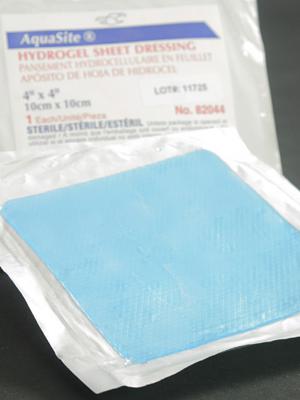Part of a series of articles for National Chemistry Week 2023 on
Unveiling the Surprising Healing Power of Chemistry
Hydrogel Dressings
Hydrogel dressings exemplify the innovative application of chemistry in wound care, offering an unexpected yet highly effective approach to promoting wound healing. These dressings, which consist of a three-dimensional network of hydrophilic polymers and water, demonstrate how the chemistry of materials can have a profound impact on medical treatments.
The chemistry behind hydrogel dressings centers on their unique composition. These dressings are primarily composed of hydrophilic polymers, such as polyvinyl pyrrolidone (PVP), polyethylene glycol (PEG), and sodium carboxymethylcellulose (NaCMC). These polymers have an innate ability to absorb and retain water, which forms the basis of the hydrogel’s structure.
The dressing’s hydrophilic nature plays a pivotal role in wound healing. When applied to a wound, the hydrogel dressing absorbs excess wound exudate (fluid), creating a moist environment around the wound site. This unexpected feature helps facilitate several crucial aspects of the wound healing process:
Moist Wound Healing: The moist environment maintained by the hydrogel dressing supports cell migration, tissue regeneration, and the formation of granulation tissue. This accelerates the overall healing process.
Debridement: Hydrogel dressings can assist in debridement, the removal of necrotic (dead) or infected tissue from the wound bed. The moist environment softens and loosens this tissue, promoting its gentle removal.
Minimized Scarring: By creating an ideal environment for wound healing, hydrogel dressings help minimize scarring. The granulation tissue formed in a moist environment tends to result in less noticeable scars.
Pain Reduction: The chemistry of hydrogel dressings provides pain relief by maintaining a moist and comfortable environment that reduces friction and irritation on the wound surface.
Hydrogel dressings have found application in various types of wounds, including burns, ulcers, surgical wounds, and pressure sores. They are particularly beneficial for wounds with moderate to high levels of exudate, as they effectively manage fluid levels while promoting healing.
Another noteworthy aspect of hydrogel dressings is their versatility in adhering to the wound’s shape and size. The chemistry behind their composition allows them to conform closely to the wound bed, ensuring even coverage and optimal contact for effective healing.
Moreover, the cooling effect of hydrogel dressings provides relief to patients with thermal burns, making them an invaluable tool in burn care. The unexpected soothing sensation adds to patient comfort during the healing process.
In conclusion, the chemistry-driven development of hydrogel dressings showcases the critical role of materials science in healthcare. These dressings, rooted in the chemistry of hydrophilic polymers and their interactions with wound exudate, offer an effective and unexpected means of facilitating wound healing, reducing pain, and minimizing scarring. Ongoing research continues to refine the chemistry and design of hydrogel dressings, ensuring their continued utility in wound care and patient comfort.





